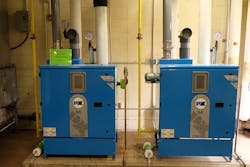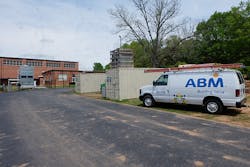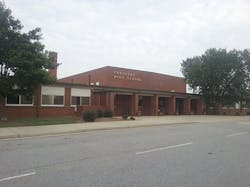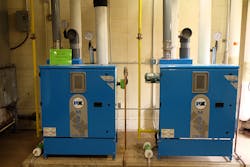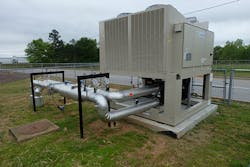ABM helps South Carolina schools upgrade facilities, save money
NEW YORK — When Rick Higginbotham tells cash-strapped school boards that they can upgrade their aging mechanical equipment and pay for some or even all of the improvements with the money they’ll save on energy costs, they often tell him it sounds too good to be true. That’s why Higginbotham, a sales executive for ABM, keeps a list of references from previous projects ready for prospective customers to call.
He’s now added the contacts from his two most recent projects in South Carolina, where ABM’s Bundled Energy Solutions program helped Anderson County School District 2 and School District 3 upgrade outdated equipment at eleven schools. The company estimates the improvements will save the school districts $6 million in energy and operating costs over the next 15 years.
Headquartered in New York, ABM helps clients throughout the country meet their infrastructure needs and achieve sustainability goals. “We go into any organization that owns or operates buildings, and we help those organizations make those buildings more energy efficient and more cost effective to operate,” said Higginbotham, who operates out of ABM’s office in Atlanta. “We help generate savings from funds they are already spending, usually with energy providers and with upkeep of aging equipment. We also do preventive maintenance.”
We go into any organization that owns or operates buildings, and we help those organizations make those buildings more energy efficient and more cost effective to operate,— Rick Higginbotham
A former school superintendent himself, Higginbotham knows many schools just cannot keep up with repairs on outdated equipment. “Often they are just putting out fires and working on old A/C equipment, trying to keep it running,” he said. “We go in and help them to upgrade or replace outdated equipment – HVAC, lighting, controls. We do water conservation. We work on the building envelope. We look for any type of energy conservation measure that can save them money.”
According to Higginbotham, the goal is to help school administrators focus on educating students, not repairing HVAC or plumbing systems. Higginbotham and Brian Ciepierski, ABM’s project manager on the Anderson County projects, shared their insights on how the programs were implemented and how they could serve as models for other educational facilities.
Getting the ball rolling
Higginbotham worked as a teacher, assistant principal, principal and superintendent in Georgia before he joined ABM in 2013. He now taps into his experience to advise his school district clients. If the school district likes the concept, the first step is a preliminary study, which is conducted at no cost to the client. At this stage the developmental team benchmarks the school buildings and calculates the energy cost per square foot. Then an investment-grade audit is conducted. “We look at every light, every motor, every pump, every compressor,” Higginbotham said. “Everything in that school we can touch, we measure.”
We look at every light, every motor, every pump, every compressor,— Rick Higginbotham
The project developer then designs a program that provides the most energy-efficient and cost-effective way to operate the buildings. At the same time, an energy engineer determines the exact amount of energy savings ABM can guarantee. Then the ABM team recommends the best systems and products to meet the client’s needs. “Every program that we do is different,” Higginbotham noted. “It’s designed specifically for that exact situation.”
The next step is to determine how much of the investment will be self-funding. ABM also works with clients to set up a lease and ensure they obtain federal and state subsidies and rebates, as well as any rebates from energy providers. Anderson 2 decided to adopt a $7.2 million program, which was designed to save $3.5 million over 15 years. Anderson 3 decided to do $5 million worth of work, with a guaranteed savings of $2.7 million over 15 years. The school districts funded the balance of their programs with 15-year municipal leases at low interest rates, and they will own all of the equipment after the lease is terminated.
Ciepierski, who has 25 years of experience in the HVAC field, the last eight years with ABM, oversaw the system upgrades for both school districts. He points to the detailed development phase as the key to success on ABM’s Bundled Energy Solutions projects. “We spend so much time in development that by the time we get the green light on a project, everything is ready and I just go to town as the project manager,” he said.
Within Anderson County School District 2, energy and facility improvements were made in the school district's three elementary schools, two middle schools, and the high school building, as well as the primary school. District-wide measures included replacing the existing lighting with LED lighting, installing new transformers, upgrading controls and sealing the building envelope. Electric hand dryers were installed throughout the district’s buildings, which saved money on paper towels and trash bags.
There is a lot of sloppy water management in kitchens. The pedal valves we install eliminate the possibility of people turning a faucet on and just walking away— Brian Ciepierski
Replacement of HVAC systems included installing 64 Carrier water-source heat pumps at Honea Path Middle School, as well as a new Lochinvar boiler and an EVAPCO cooling tower. The HVAC systems covering the guidance office, library, gym and principal’s office in both middle schools were replaced with Daikin mini-split systems.
In Anderson County School District 3, ABM provided infrastructure upgrades within its three elementary schools, the middle school, the high school and the Board of Education building. In addition to district-wide LED lighting, energy efficient transformers and water conservation measures, improvements included new controls and PC power management software that made the system’s computer network more energy efficient.
New HVAC units at Crescent High School included two Daikin air-cooled chillers, two Patterson-Kelley boilers, 40 Trane unit ventilators and 13 Trane fancoil units. Daikin VRV split systems were installed to provide front office air conditioning three schools. Other products installed included Taco pumps and Spirotherm air and dirt separators.
Water conservation measures were crucial in both of these projects. Low-flow toilets and urinals from Kohler were installed in the bathrooms. Kitchen sinks were retrofitted with pedal valves to limit water waste in cafeterias. “When we perform work in the schools, we pay a lot of attention to the water use in cafeterias,” Ciepierski says. “There is a lot of sloppy water management in kitchens. The pedal valves we install eliminate the possibility of people turning a faucet on and just walking away.”
Challenging installation
Installation began in the fall of 2015, so scheduling was a concern, as regular school activities could not be disrupted. “All of our activity on these jobs was done on second shift, starting at 3:30 in the afternoon and working until about 2 in the morning,” Ciepierski said. “On the significant infrastructure interruptions — chillers, cooling towers, boilers, hot water heaters — all of that takes place on the weekend.”
We need to have the phone number of the supply house and be ready to pay the extra price to have them open the garage doors so we can roll in there, get another 20 flanges or whatever we need, and come back to the job and keep working through the night,— Brian Ciepierski
For weekend projects, planning ahead is critical. The foremen, crews and any subcontractors make sure all materials are ready to go. They also have to be ready in case of emergencies. “We need to have the phone number of the supply house and be ready to pay the extra price to have them open the garage doors so we can roll in there, get another 20 flanges or whatever we need, and come back to the job and keep working through the night. So all of those things are in place when we do one of those crunch weekends.”
Weekend projects included replacing water-based chillers with air-cooled chillers to help cut water costs. Ciepierski made sure the transition was seamless. “In order to get that done, we will leave the existing infrastructure operating and we’ll get the new chiller wired, piped and controlled before we integrate it with the building system,” he said. “We start on Friday night and work three shifts until Sunday afternoon. We’ve got those down. It’s almost like a three-day-long pit stop.”
The Daikin split systems specified for the administrative offices were also installed while the old systems were still running. Crews used aluminum tubing with Refloc fittings for the refrigerant lines to avoid using torches in the plenums. The aluminum was cheaper than copper and easier to install, cutting labor costs.
A few surprises
Old buildings can be full of surprises. At Crescent High School in Anderson 3, for example, Ciepierski discovered there were no isolation valves in pipes throughout the school, so the entire system would have to be drained to work on any of the wings. “This would add hours of labor,” he notes. “At one point we drained the whole system and put in 150 valves to expedite our night work. We just took the hit on the job.”
We proved by cutting out a sample of the pipe and sending it out for testing that the walls of the pipe were sufficient, so we the dried out the plenums during the summer months and put a coating on it that added R-Value,— Brian Ciepierski
Crews also discovered that some interior walls extended through the acoustical ceiling but were never properly completed, in violation of the building code. “These demising walls were supposed to run all the way up to the deck, but they didn’t, so piping had to be rerouted to go through true demising walls to meet the fire rating,” Ciepierski said. “That had to happen, but it was a time penalty and a dollar penalty.”
The ABM team also tackled other problems they discovered. At Iva Elementary School, for example, condensation from a poorly insulated chiller pipe had been dripping onto ceiling tiles. The school’s maintenance crews had been working under the assumption it was a roof leak, and they were changing out 75 to 125 ceiling tiles a week. “We proved by cutting out a sample of the pipe and sending it out for testing that the walls of the pipe were sufficient, so we the dried out the plenums during the summer months and put a coating on it that added R-Value,” he said. “We eliminated the sweating by creating a vapor barrier around the pipe.”
ABM tackled these additional tasks without change orders or additional cost for the school districts. “We just had to make it work,” said Ciepierski. “We have a guarantee. We guarantee the energy savings on these projects, and we were able to do that on this job, even with all of these difficulties.”
Work is now complete at Anderson 3 and just wrapping up at Anderson 2, and Higginbotham and Ciepierski note that feedback from the school districts has been overwhelmingly positive.
Dr. Richard Rosenberger, Superintendent for Anderson School District 2, notes the schools’ maintenance departments can now focus on routine preventive maintenance, instead of frantic band-aid repairs. It’s also helped improve the learning environment. “It’s made a big difference in what we’re trying to accomplish here in the district,” Rosenberger said.
Rosenberger also believes the partnership with ABM shows the school board is being proactive when it comes to taking care of the buildings’ infrastructure. “The people want to know you are good stewards of the taxpayers’ money, and this program proves we’re doing the best job possible with it,” he concludes.
Christopher King is a writer and editor who has covered the construction industry for more than 15 years. He previously served as editor of Roofing Contractor, managing editor of the Air Conditioning, Heating & Refrigeration News, and associate editor of Plumbing & Mechanical. He can be reached at [email protected].
